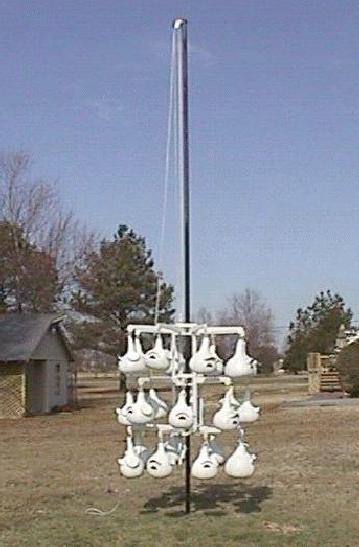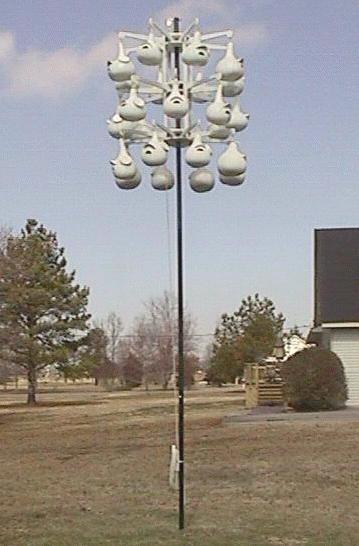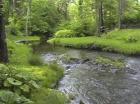
Purple Martin Pages
![]() Requirements for martins
Requirements for martins
![]() The Martin Bio
Page
The Martin Bio
Page![]() The
Habits Page
The
Habits Page![]() Tips to Attract
Them
Tips to Attract
Them
![]() Nest
Checks
Nest
Checks
![]() T-14
Mounting
T-14
Mounting![]() Purple Martin
Housing
Purple Martin
Housing

Visit Our Partners
A Bird's Home
The Gourd Page
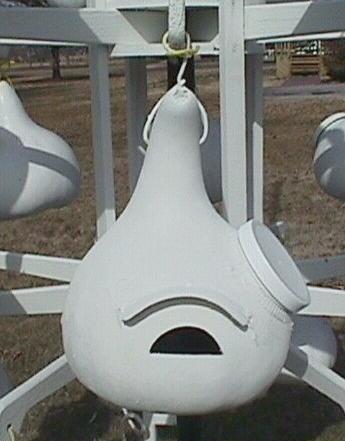
Because I've received so many E-mails on my Purple Martin Page about natural gourds and how to either, acquire them, raise them or prepare them for purple martins, that I've decided to create a page just for gourds. Now, I knew that other people used gourds for purple martins besides me, but I didn't realize they were so popular. Therefore, I'll try to put as much information here as I can so everyone will have a clear understanding about them. To accomplish this, I will use information from other web sites, excerpts from books and/or pamphlets along with first hand knowledge from myself and/or others that grow them.
First,
I'd like to make one thing clear. I'm no expert and don't proclaim
to be. However, I have grown a lot of gourds, know a little bit
about them and use them primarily in my martin site. I just seemed
to have better results with gourds than any other kind of housing in my
area.
May I also add, most of the general growing and handling
information contained here will work for just about any gourd species, but
the specific martin information is going to pertain to gourds used for
housing purple martins. In my case, they are of the Lagenaria family. If
you're growing other kinds and want more information, there are many other
pages that have information on gourds for other purposes. A few are
displayed below, plus The American Gourd Society can be contacted
through the address and phone number given further down this
page.
Please note:
In these pages, I will try and answer
all questions pertaining to gourds to be used for purple martins or bird
nesting in general. If you have questions about other uses or the artistic
values of gourds, please contact some of the folks below. That is their
thing and they will be able to answer your questions much better than I
will. And if you check out a few of their links, you'll quickly understand
why. There is a lot of talent in this world, and some of it is displayed
in the gourd links below.
Gourd Basics
The gourd family covers a broad spectrum of vined plants. It ranges from the edible kind, such as pumpkins, squash and cucumbers all the way through the inedible kind such as, well, hard-shelled gourds. That's the kind of gourds we're going to concentrate on. The dictionary describes these hard-shelled versions as: "any of various hard-rinded inedible fruits of plants of two genera (Lagenaria and Cucurbita) often used for ornaments or for vessels and utensils."
Gourds are used for a number of different reasons depending on the type you have. Some are small and colorful with all kinds of weird and interesting shapes and usually used for ornamental purposes. These are usually a soft shelled gourd and you often see these in little ornamental baskets for decorations.
Some are intermediate sized and are used for bowls, pots, jugs and drinking vessels. These are often the favorites for artisans and are used for artistic purposes and most of the artistic crafts. You'll see a lot of these at gourd and craft shows.
Then
there's the larger sized that are basically used for birds houses.
These are the bottle gourds and are the kind we're interested in.
They are often called "bird house gourds", because that's what the early
Indians used them for. They discovered that if they cut holes in them,
cleaned them out and hung them in trees or on poles around their gardens,
birds would use them as a nesting site. They quickly found that, as they
put more of them up, if they could get a certain kind of bird to use them,
the insect population around the general village declined. As the purple
martins discovered the gourds, they left the holes in the trees and
assumed the gourds as living quarters. Because the constant commotion
around the gardens kept other birds away from the gourds, the martins soon
learned that being around man was beneficial to them. Man supplied them
with nesting sites, kept other birds away from the gourds and they had
places to rear their young, thus, the beginning of a long and happy
relationship between man and the purple martin.
|
|
|
|
artwork courtesy J. Hill III, PMCA |
Gourd Links
For
those that are interested in the artistic side of gourds, the following
are a few links that will get you started.
Some of these links show
just how creative people can be so if art is your bag, check them
out. They'll have other links that'll get you to where you want to
go.
And here's another Natural
Reflections Marketplace
And another Inseason
And still another Gourd
Craft
A little imagination, paint and, 'voila' More Gourd
Craft
If
you would like more information on gourds other than what's found here or
would like to talk to some experts, you can contact:
The
American Gourd Society
P.O. Box 274
Mt. Gilead, Ohio
43338-0274
(419) 362-OHIO (6446)
Here's the link to
The American
Gourd Society.
Email: info@gourdcentral.com
Purchasing Gourds
If
you've neither the time, nor the room to grow your own martin gourds, but
would like to acquire some for your own use, then you can buy them. All
you have to do is find them, and just about everybody knows somebody else
that grows gourds. If you live anywhere near an Amish Settlement, they
almost always have gourds of all kinds for sale. They also use gourds for
purple martins. Often, some craft shops and/or garden shops will know of
someone that raises them.
If all your efforts fail to locate any,
then you can contact the Purple Martin Conservation Association and they
will sell you some.
Their Address is:
Purple Martin
Conservation Association
Edinboro University of
Pennsylvania
Edinboro, PA 16444
Ph:
814-734-4420
You can contact them by E-mail:
pmca@edinboro.edu
You can get their catalog with all kinds
of items you can acquire for purple martins, including gourds. They are
already cleaned, drilled and ready to be treated, painted and
hung.
Gourd Suppliers
Since
the original idea of this page is to tie purple martins and gourds
together, the rest of this page will primarily concern itself with easy to
build and inexpensive housing for martins. Housing that is light, easy to
work with and in just about anybody's' price range and best of all, it
will attract purple martins. And of course, it will consist of
gourds.
But, before we get into raising purple martins in gourds,
if you are not totally familiar with the rules for attracting and keeping
purple martins and if you have not already done so, I suggest you take a
look at my purple martin page. It has a lot
more details about martins that are not on this page and may answer a few
questions that you might have about keeping them.
There's one thing
said there that I'd like to reiterate here and that's the location of any
purple martin site. It should have a lot of landing room. Martins like to
swoop into their nests, and if there are any tall trees or other hindering
obstructions close by, it's going to be very difficult for the house to
attract them. No structures of any kind taller than the martin house
should be within 60 feet of the site. They just won't come. However,
this does not apply to 'human' housing. It can be as close as 30
feet as long as it isn't taller than the martin housing.
Before
erecting your site, think about a location for the site where there will
be no hindrances for the martins when they approach the site. Things
like tall buildings and trees give an ambushing hawk the advantage and
martins don't like it and therefore, won't nest in such conditions.
Martins
like to sit on phone wires, but if those wires are in the flight path to
their nests, they now become a hindrance, thus a possible deterrence to
martins nesting in your site. May not seem like much, but sometimes that's
all it takes to make or break a site. However, if the martins decide
that you have a good site location, then they will readily settle in and
take up residence.
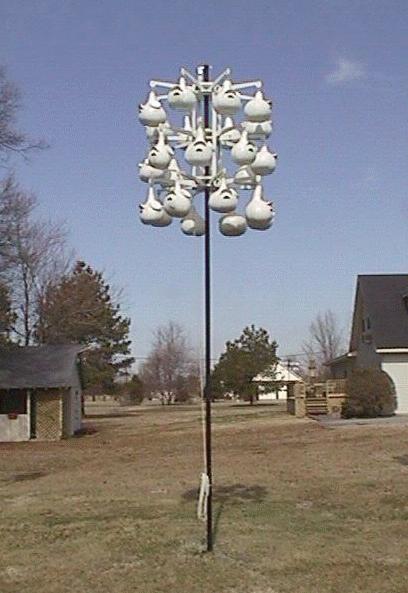
Gourd Systems
If you plan to supply gourds for martin housing, one of the things that will have to be considered is HOW you plan to offer them. There are many different options available ranging from long straight lines of gourds, ' T ' shaped poles, poles with metal wheels or old rake tines, and so on. I didn't really care for any of those so I decided to design my own. The system you see above is one that I designed and is one of four that are in my yard near my home. I developed it because I just wasn't happy with the other forms of poles that were available. The following is why I designed my own gourd rack.
For years I'd tried to attract martins to my martin 'house' without success. They came, but never stayed. Then, a friend suggested that I put up some gourds and bingo, I had martins move in the first year. The gourds happened to be on a 'T' shaped pole that did not come down easily and therefore, maintenance was a very big problem. The pole was too high and I couldn't get at the gourds to take care of them. I even had some sparrows move into one of the other gourds, and I couldn't easily get to them to remove them. There just had to be a better way, so I went into my wood shop, sat down in the doorway and watched the birds and looked at the pole and thought about it. If I couldn't get up the pole to get to the gourds, why not bring the gourds down to me.
Then and
there, I decided to come up with a system where I could mount my gourds
and yet, get at them easily to perform maintenance on them. At the same
time I wanted them to be aesthetically appealing. I also designed in a
pulley system that really makes the whole thing happen. The pulley
system is a block and tackle design and will easily handle all the weight
of the gourds and the martin materials inside the gourds. Thus, the
system you see above. Normally, the design only contains two levels,
but I had so many martins coming that I had to go to three levels.
Yes, it's a little heavier, but the pulley system handles it easily.
I now have 4 poles in my site, 2 with 3 layers of gourds as shown above
(and below) and 2 with 2 layers as the design was originally
intended.
Now, I didn't come up with the idea of putting up gourds.
I also didn't come up with the idea of raising and lowering them. I just
refined it to suite my liking. The maintenance of the unit is quick
and easy, while at the same time, low cost and what I think to be
attractive. The unit is also easily accessible from any direction
for the martins. The system is lightweight but strong and will mount 16
gourds on 2 layers on a steel pole. It's very easy to care for.
Everything to make the unit is readily available in your local lumber yard
and hardware store, except the gourds, and they are usually available with
a little inquiring around. If you really get into it, and you have the
room, you can keep a few seeds and grow them. As far as tools required to
build the unit, all you will need is everyday hand tools the average
person keeps around the house such as a jigsaw, drill, simple wrenches and
pliers.
|
|
| |
|
Slides down the pole for easy access |
Easily slides up the pole so martins can use it |
The
plans call for only 2 layers of gourds, but as you can see, a third can
easily be added if you're strong enough to handle the extra weight.
The unit will cost approximately $100.00 to build and set
up. Since I grow my own gourds, that helps with the cost.
The cost may vary depending on the area, the price of the materials for
that area, and the amount of work you want to put into it.. I believe this
cost is within the range of just about anyone who would be interested in
attracting these delightful birds. And once you finally do get a colony
started, it will be worth every minute of work and every penny you spent
to just sit back and watch them as they effortlessly float through the air
eating insects and thus making life a little better for you.
If
you want one, you can build one.
What I've done is put together
a small packet that explains all you need to know to build a two level
Purple Martin slide system and mount it on a pole and start your own
colony. All the instructions required to build and erect one of these
units is contained in the packet.
It includes a complete itemized
list of materials, drawings and assembly procedures for assembling the
entire unit, instructions how to put in a ground socket, put the pole up
and how to attach the slide and gourds to it. There's even a few
maintenance tips for the pole, gourds and wooden parts.
If you like
the way my system looks and your interested in putting one up and you
don't mind helping pay for my computer time and copying costs, then send a
check for $10.00, along with a Self Addressed #10 Envelope (Legal Size)
with enough postage to cover 2 ounces on it to the address
below and I'll send you the packet.
Chuck Abare
17835 Oakdale
Rd
Athens, Al, 35613
Might I also add, this system is
very light and can easily be raised and lowered by folks that may be
slight in stature or maybe a little on the older side like me. There's no
pinching of fingers like with telescoping poles. There's no tipping of the
gourds like on poles that pivot to lower them for inspection. There's no
climbing of ladder to get at the hard mounted systems thus making thing
safer. If you'd like one, but for some reason, don't have the
ability to make one, check with a friend that probably could do it for
you. Most everyone knows someone that has a garage, a few basic tools and
the know how to read basic drawings and build a basic structure like
this. Depending on the skill level, it takes about one weekend to
build one and assemble it. Painting depends on how long the paint
takes to dry.
One more thing. Just because you put up one of these
poles is no guarantee that you're going to get a Purple Martin colony.
(Although I'll give you better odds than if you tried to attract them to a
house). There are rules that have to be followed to attract martins to new
sites and the same goes for this structure also. It's young martins that
overflow from other sites that usually start new colonies because the
older established birds will return to the original house they nested in
year after year, even the same nest if possible. It might take some time
to get a colony established. This is something that's very hard to
predict and sometimes, patience is a must. What you have to do is make the
site as appealing as possible to the martins and if they like it, they
will stay. Mine did. It is generally accepted that two nesting pair is
considered a colony. Then, as long as there are nests available, some of
the young will also return to the same area the following year, and maybe
bring others with them, thus your colony will grow. All I can do is
suggest you try it and see what happens. Who knows, you might get lucky
too.
 Gourd
Basics
Gourd
Basics
 Gourd
Links
Gourd
Links
 Growing
Gourds
Growing
Gourds
 Harvesting
Gourds
Harvesting
Gourds
 Some Gourd
Pests
Some Gourd
Pests
 Drying
Gourds
Drying
Gourds
 Gourds To
Birdhouses
Gourds To
Birdhouses
 Access Doors &
Canopies
Access Doors &
Canopies
 Painting
Gourds
Painting
Gourds
 Storing
GourdsPurchasing
Gourds
Storing
GourdsPurchasing
Gourds
Why 10" gourds?
Back to Chuck's Purple Martin
Page
This page created and maintained
by
Chuck Abare

|

 1999 -
All Rights Reserved 1999 -
All Rights Reserved
| |

